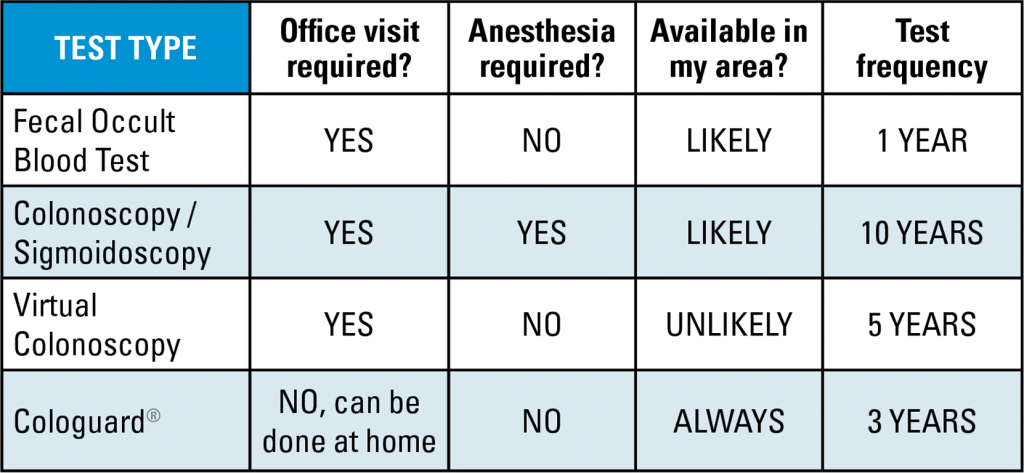colorectal cancer screening
THE MOST PREVENTABLE CANCER IS THE LEAST PREVENTED
Colorectal Cancer (CRC) is the 3rd most commonly occurring cancer in either men or women, and it’s expected to increase 90% by 2030 in younger populations. The good news is, if caught early through screening, it’s treatable in 9 out of 10 people.
- CRC is the 2nd leading cause of cancer in the U.S. among men and women.
- Many patients with early-stage CRC have no symptoms, making proactive screening the only way to detect CRC.
- Regular screening is recommended beginning at age 45 for people at average risk according to the American Cancer Society.
- There has been a 51% increase in incidence of CRC since 1994. Regular screening as soon as you are due may help to catch cancer early.
- CRC affects all races, genders, and ethnicities. All races, genders, and ethnicities should screen for colon cancer.
4 Options for Colorectal cancer screening
Colon Cancer Screenings are offered as a preventive care benefit at no cost. This coverage is subject to limitations, including the frequency of testing and age. The results can tell you and your healthcare provider important information about your CRC risks. There are many options for screening and these tests can find polyps or cancer before you even have symptoms. Early detection may prevent polyps from becoming cancer and could jump-start treatment, when it is most effective. Talk to your doctor about screening for colon cancer at your annual wellness exam.
When to begin screening?
The American Cancer Society recommends that adults at average risk should begin colon cancer screening at age 45.
Fecal occult blood test
A fecal occult blood test (FOBT) is a test to check stool (solid waste) for blood that can only be seen with a microscope. A small sample of stool is placed on a special card or in a special container and returned to the doctor or laboratory for testing. Blood in the stool may be a sign of polyps, cancer, or other conditions.
Colonoscopy / Sigmoidoscopy
Sigmoidoscopy is a procedure to look inside the rectum and sigmoid (lower) colon for polyps, abnormal areas, or cancer. A sigmoidoscope is inserted through the rectum into the sigmoid colon. A sigmoidoscope is a thin, tube-like instrument with a light and a lens for viewing. It may also have a tool to remove polyps or tissue samples, which are checked under a microscope for signs of cancer.
Colonoscopy is a procedure to look inside the rectum and colon for polyps, abnormal areas, or cancer. A colonoscope is inserted through the rectum into the colon. A colonoscope is a thin, tube-like instrument with a light and a lens for viewing. It may also have a tool to remove polyps or tissue samples, which are checked under a microscope for signs of cancer.
Virtual Colonoscopy
Virtual colonoscopy is a procedure that uses a series of x-rays called computed tomography to make a series of pictures of the colon. A computer puts the pictures together to create detailed images that may show polyps and anything else that seems unusual on the inside surface of the colon. This test is also called computed tomography colonography or CTC.
COLOGUARD® DNA stool test
This test checks DNA in stool cells for genetic changes that may be a sign of colorectal cancer.
Cologuard® is an effective, noninvasive colon cancer screening that is done at home, not in a health care facility, and it requires no preparation and no time off of work.

Risk Factors
Early screening is recommended for individuals with certain risk factors, including a family history of colon or rectal cancer, previous removal of specific polyps during a colonoscopy, a personal history of colon or rectal cancer, prior radiation treatment to the abdomen or pelvic area for another cancer, or a diagnosis of inflammatory bowel disease.Need More help with colon cancer screenings?
Our Population Health care team will answer any question you may have about colon cancer screenings.
Call: 1-866-204-7132
Email: [email protected]
 Personalized digital tools and resources for tracking nutrition, physical activity and overall well-being from the comfort of your home.
Personalized digital tools and resources for tracking nutrition, physical activity and overall well-being from the comfort of your home.